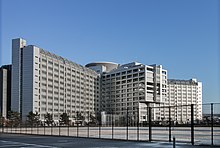Penal system of Velikoslavia: Difference between revisions
| Line 22: | Line 22: | ||
==Penal institutions== | ==Penal institutions== | ||
===Prisons=== | ===Prisons=== | ||
[[image:2018 Tokyo Detention House.jpg|thumb|right|220px|Omega Urban Correctional Complex, Zarinsk]] | |||
[[category:Government of Velikoslavia]] | [[category:Government of Velikoslavia]] | ||
Revision as of 16:22, 12 December 2023
The penal system of Velikoslavia is part of the Criminal justice system of Velikoslavia. The system is intended to resocialize, reform, rehabilitate and punish offenders. All prisons are overseen by branch of the Ministry of Justice, the Office of Correctional Affairs. There are three levels of imprisonment in Velikoslavia; low level sentencing which is typically served in a local jail, sentencing to a medium security facility, or sentencing to one of the high security facilities in eastern Velikoslavia. For particularly dangerous criminals or those deemed unable to be rehabilitated, two supermaximum facilities exist, one of which contains facilities to carry out capital punishment, though this is used less frequently in modern times.
In 2023, 75,640 people were under the supervision of the criminal justice system. Of this population, 50,320 are for violent crimes, 14,402 are for drug offenses, and 10,936 are for property offenses. Since 2004, incareration rates have declined slightly as more initiatives have been introduced to rehabilitate certain offenders without being incarcerated, with practices such as probation being utilized in a greater way. Programs to provide mental health counseling and other services to prisoners have also steadily been on the rise since 2010 when Alexis V introduced a specific decree providing greater funding for the practice. Debtors' prisons were officially abolished in 1972, and as of 1984, people cannot be imprisoned for unpaid debt, though many legal programs exist to provide restitution to the entity for whom the money is owed.
Velikoslavia is estimated to spend an average of 3 billion annually on incarceration costs.
Procedure
Prisoners in Velikoslavia have an intake procedure designed to place prisoners in areas which they are best suited. Those sentenced to low security facilities for short times, such as jails, are permitted to report for their sentence at an assigned time where they are classified according to gender, race, and nationality then placed in the facility. Those sentenced to higher security facilities are held in custody in lower security facilities under guard temporarily while transport is arranged to an appropriate facility that has room. There are several gender specific facilities that take only women, and several other facilities with gender specific wings that segregate the genders and prevent interaction between male and female prisoners in order to maintain order. The two supermax facilities, Anovsk Prison and Camp Arktion, rarely see female prisoners, as they typically are only sent to lower security facilities. Aristocrats typically are sent to two prisons that have specific wings for them. Segregation from the general prison population is the only boon an aristocrat receives and they are incarcerated under the same conditions as commoner prisoners. Aristocrats that are sent to supermax facilities are imprisoned with the general prison population.
Once in the prison, a psychiatric assessment is performed on the inmate to determine a path forward. Any prisoner not sentenced to a supermax facility is evaluated and offered the chance for rehabilitation. Those who show no interest in the process or decline are required to serve their full sentence. Those who cooperate and show a willingness to move forward can potentially shorten their sentence if they cooperate with the process and may get the opportunity to move to a lower security rehabilitation facility.
